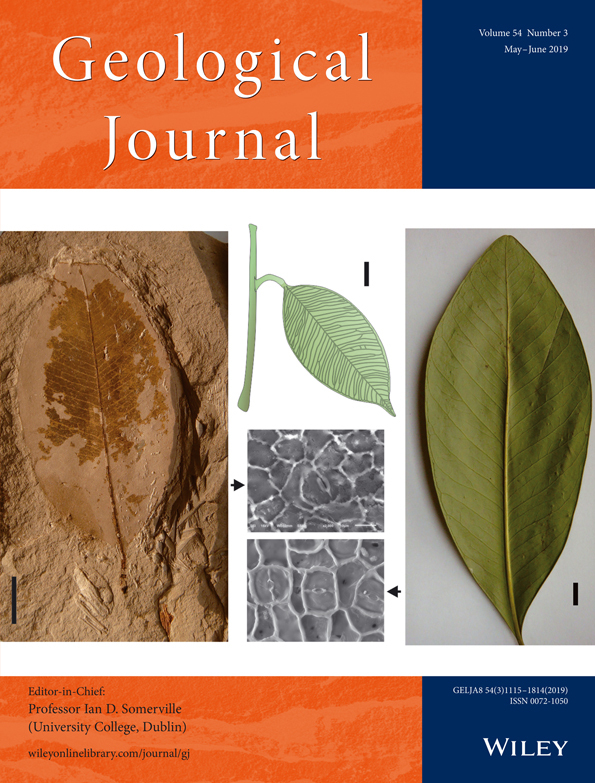First report of a Messinian coralgal facies in a terrigenous setting of Central Apennines (Italy) and its palaeogeographic significance
Abstract
The upper Miocene dominantly terrigenous succession cropping out at Monte San Fabrizio (Simbruini Mts.) shows peculiar, previously unreported bio-sedimentological features, which bring fresh elements in a regional palaeogeographic/palaeotectonic key. Overlying the regional foredeep succession, an array of different lithofacies either form mappable outcrops or occur as clasts, remarkably not referable to any stratigraphic units already known in the Central Apennines. These lithologies, which include coral-bearing siliciclastic sediments, mixed carbonate/siliciclastic deposits with benthic macrofaunas, rhodalgal facies, and conglomerates, essentially made of Mesozoic pelagic lithoclasts, are here grouped in a comprehensive informal unit, called Monte San Fabrizio Unit (MSFU). The most striking feature of the MSFU is a coralgal facies characterized by the occurrence of zooxanthellate (z) corals (Porites and Siderastrea crenulata). While the age of these deposits is not directly determinable due to the lack of biostratigraphic markers, their composition and field relationships clearly place their origin within a late-orogenic setting: only the uplift, subaerial exposure, and erosion of large portions of the pre-orogenic stratigraphy, also belonging to different geological domains, and subsequent sediment transport by rivers, can account for the heterogeneous composition of the conglomerates. Their sedimentological characters (i.e., shape and size of the clasts) suggest reworking of the pebbles in a shore environment. A shallow marine photic environment is confirmed by the presence of z-corals, red algae, and abundant macrofauna. The occurrence of Porites and Siderastrea crenulata represents the first occurrence of corals subsequent to the drowning of the bryozoan limestone carbonate factory, being the youngest occurrence of corals in the Central Apennines and the first ever post-Burdigalian z-corals described in the region. This also constrains the age of the MSFU as early–middle (pre-evaporitic) Messinian, due to the almost total demise of z-corals known in the Mediterranean in response to the Messinian Salinity Crisis. In conclusion, sedimentology, palaeobiology, and field geology all point to a shallow-water environment, close to a shoreline, for the MSFU. This unit can be interpreted as representing the vestiges of an ephemeral depositional environment, such as a small wedge-top basin, an evidence that this portion of the Apennine chain was already structured in the early–middle Messinian.
1 INTRODUCTION AND GEOLOGICAL SETTING
In the northern Simbruini Mts., at Monte San Fabrizio (Figure 1), between the villages of Oricola and Rocca di Botte (Abruzzo Region—Central Apennines), the upper Miocene stratigraphy of terrigenous deposits, decribed herein for the first time, represents a geological unicum in the region.

The Miocene stratigraphy of Central Apennines (Latium–Abruzzi Domain) has been extensively described in the literature. It begins with a carbonate unit (bryozoan limestone) paraconformably (or disconformably) capping, although with local exceptions, upper Cretaceous carbonates (rudist-dominated limestones) which are part of a very thick shallow-water carbonate succession developed since the late Triassic in the region (B. Accordi et al., 1969; Brandano, 2017; Damiani, 1990; Damiani et al., 1991; Damiani, Molinari, Pichezzi, Panseri, & Giovagnoli, 1990; Fabbi, 2016; G. Accordi & Carbone, 1988; M. Chiocchini, Chiocchini, Didaskalou, & Potetti, 2008; Parotto & Praturlon, 1975, 2004).
The drowning of the bryozoan limestone in the late Miocene (Bergomi & Damiani, 1976; Civitelli & Brandano, 2005; Compagnoni et al., 1991; Compagnoni et al., 2005; Corda, 1990; Damiani et al., 1990; Fabbi, 2016; Fabbi, Galluzzo, Pichezzi, & Santantonio, 2014) marks the end of the shallow-water carbonate sedimentation that characterizes the long (>200 Myrs) geological history of the Latium–Abruzzi Domain.
Above the carbonates, a terrigenous succession documents the involvement of the whole area in the apenninic foreland basin system (Bigi, Costa Pisani, Milli, & Moscatelli, 2003; Carminati, Fabbi, & Santantonio, 2014; Cosentino, Cipollari, Marsili, & Scrocca, 2010; Fabbi, 2016; Fabbi et al., 2014; Parotto & Praturlon, 2004; Patacca, Sartori, & Scandone, 1990; Royden, Patacca, & Scandone, 1987). This terrigenous succession is composed of the “unità argilloso marnosa” (UAM), a thin hemipelagic unit, followed by a very thick turbiditic sandstone/marl alternation (“complesso torbiditico altomiocenico laziale-abruzzese”), representing the apenninic foredeep sedimentation (Cipollari & Cosentino, 1991, 1995; Compagnoni et al., 1991; Compagnoni et al., 2005; Fabbi, 2016; Fabbi et al., 2014; Milli & Moscatelli, 2000; Pampaloni, Pichezzi, Raffi, & Rossi, 1994). The foredeep deposits display younging towards the eastern quadrants, following the advancement of the chain.
The present-day Simbruini Mts (Figure 1) represented an extensional structural high in the late Miocene foreland basin system (Carminati et al., 2014; Cavinato, Parotto, & Sirna, 2012; Compagnoni et al., 2005; Critelli et al., 2007; Fabbi, 2016; Fabbi et al., 2014). Its margins were dismantled, producing a huge clastic deposit exposed along the eastern slopes of the Simbruini Mts., the “brecce della Renga fm.” (Compagnoni, Galluzzo, & Santantonio, 1990; Devoto, 1967; Fabbi & Rossi, 2014). That high separated two troughs dominated by siliciclastic turbidite sedimentation: westwards the Latina Valley, where the siliciclastic input was essentially late Tortonian (U. Chiocchini & Cipriani, 1989; Cosentino & Cipollari, 2003; Cosentino et al., 2010; Moscatelli et al., 2004), and eastwards the Val Roveto–Salto–Tagliacozzo siliciclastic basin (Figure 1), developed essentially in the early Messinian (Castorina et al., 1996; Compagnoni et al., 2005; Fabbi et al., 2014).
When foredeep basins became part of the accretionary wedge, several local basins developed in wedge-top settings (Cipollari, Cosentino, & Gliozzi, 1999; DeCelles & Giles, 1996). Sedimentation in these basins was dominated by conglomerates and massive sands, coupled with clays whose microfossil and nannofossil content has allowed to determine the age of almost every wedge top deposit, the oldest being the Gavignano–Gorga unit (Volsci Range—late Tortonian) and the youngest being the Le Vicenne basin (eastern Marsica—latest Messinian/Pliocene) (Cipollari, Cosentino, Esu, et al., 1999; Cosentino et al., 2010; Cosentino & Cipollari, 2003; Cosentino & Cipollari, 2012; Gliozzi, 1999). Remarkably, neither in these basins nor elsewhere across the region had the occurrence of shallow marine successions with photic biota, subsequent to the drowning of the bryozoan limestone, ever been previously reported.
Post foredeep-stage deposits in the Latium–Abruzzi domain often have a low preservation potential, essentially due to their ephemeral nature, coupled with rapid erosion and structural elevation of the chain. Based on the age of wedge-top deposits, some authors concluded that a wide portion of the Central Apennines (from the Volsci Range to eastern Marsica) became involved in the chain-building during a time spanning the late Tortonian to the late Messinian (Cosentino & Cipollari, 2003; Cosentino et al., 2010; Cosentino & Cipollari, 2012). Regarding the study area, the timing of involvement of the Simbruini tectono-stratigraphic unit in compressional tectonics is still object of debate in the literature, being considered early Messinian (Cipollari & Cosentino, 1991; Cipollari, Cosentino, & Gliozzi, 1999; Cosentino et al., 2010; Cosentino & Cipollari, 2012; Patacca, Scandone, Bellatalla, Perilli, & Santini, 1991) or middle/late Messinian (Bigi et al., 2003; Carminati et al., 2014; Fabbi, 2016; Fabbi & Rossi, 2014).
Regardless of the age of deformation, the Monte San Fabrizio Unit provides the rare opportunity to observe a snapshot of sedimentation along the palaeo-coastline on top of a growing thrust.
2 THE MONTE SAN FABRIZIO OUTCROPS: FACIES DESCRIPTION
The terrigenous and mixed carbonate/siliciclastic succession exposed at Monte San Fabrizio (Figure 1) had previously been investigated only for the realization of the Sheet #367 Tagliacozzo of the Geological Map of Italy 1:50000 (Compagnoni et al., 2005), where it had been tentatively interpreted as belonging to the upper Miocene terrigenous succession (Orbulina marls and “complesso torbiditico altomiocenico laziale-abruzzese”), although showing unusual characters (e.g., shelly macrofauna).
The peculiar facies found at Monte San Fabrizio include coral-bearing arenites and conglomerates, sandstones with large bivalves and gastropods, rhodalgal/bryozoan bindstone/framestones with zooxanthellate corals and other benthic biota, and conglomerates essentially made of Mesozoic pelagic lithoclasts. Only small, sparse outcrops exist of these unusual lithologies, which are often found only as scattered clasts and have been grouped in the informal Monte San Fabrizio Unit (MSFU) (Figure 1d).
Outcrop conditions of the MSFU are generally very poor (Figure 2), but the available exposures allow to reconstruct a stratigraphic succession (Figure 3) based on geological mapping coupled with palaeontological analysis of >60 samples collected across an area of less than 1 km2, also including two core samplings.
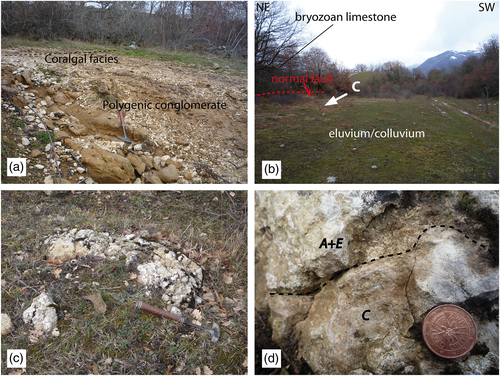
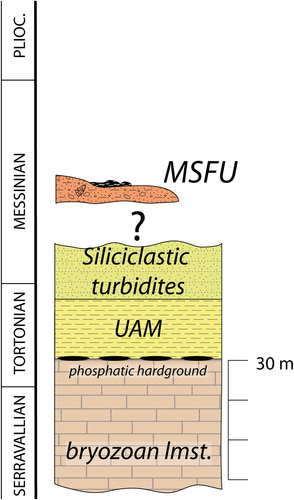
The substrate of the MSFU is represented by the regional middle–upper Miocene succession. In the investigated area, the passage from the bryozoan limestone to the UAM (Orbulina marls) takes place through a mineralized hardground, as commonly observed in the Latium–Abruzzi Domain (Corda, 1990; Fabbi, 2016; Zalaffi, 1963). The thickness of the UAM is difficult to determine, due to present day erosion and to later tectonic deformation, but is inferred, based on the most complete section, as being about 20 m. Above the marls less than 20 meters of turbiditic sandstone/marl alternations can been interpreted as representing the lowest part of the turbiditic foredeep succession, the remainder of the turbidites having been eroded along the basal unconformity of the overlying MSFU.
The MSFU, also considering the totality of displaced clasts, comprises an array of different facies.
- I-
The coralgal facies
- II-
The polygenic conglomerate
- III-
The displaced lithoclasts and boulders
- I The “coralgal” facies (Figure 4) is characterized by the occurrence of zooxanthellate corals (Siderastrea crenulata—Antonio Russo, personal communication—and Porites sp.) and coralline red algae (Lithoporella sp., Lithophyllum sp. and Spongites sp.) associated with several benthic organisms (Figure 5), also including bivalves and gastropods. These benthic carbonate assemblages form small patches characterized by low siliciclastic content (Figure 4c,d), surrounded and locally embedded in a dominantly terrigenous polygenic fine sand to pebble grain size sediment which also bear coral fragments. Red algae are abundant, along with Polychaeta worm tubes (serpulids), benthic encrusting foraminifers (Acervulinidae and Planorbulinidae), microbial crusts, and vermetid gastropods, forming bindstones that also embed coral fragments, lithoclasts, or other red algae (Figure 4). Both the lithoclasts and bioclasts are commonly well rounded and bioeroded, suggesting reworking in a high-energy shallow-water environment.
- II The polygenic conglomerate (Figure 6) is a fine- to coarse-grained conglomerate (grain size: <1 cm to >10 cm) mainly composed of rounded pebbles belonging to the Mesozoic Umbria–Marche–Sabina pelagic succession, embedded in a mixed carbonate/siliciclastic arenite matrix, which also contains Miocene larger benthic foraminifers (Heterostegina, Elphidium, Amphistegina).

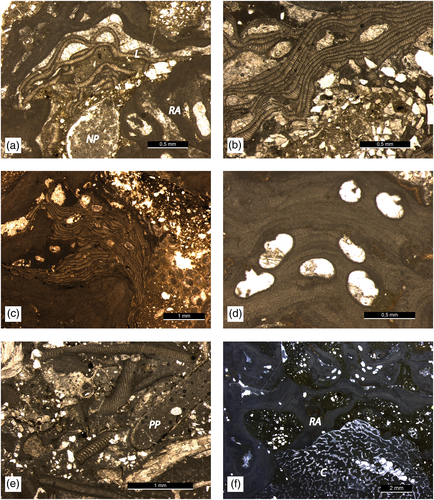
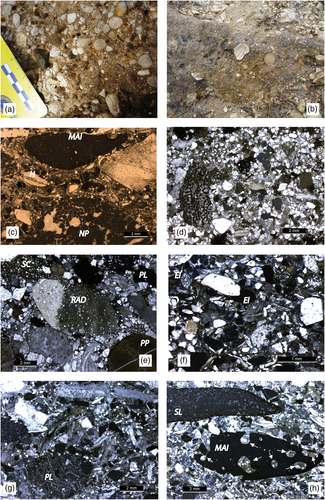
- III The displaced clasts (Figure 7) represent lithologies unknown in the region outside the Monte San Fabrizio area. They include i) laminated calcarenites essentially made of pelagic foraminifers; ii) limestone boulders bored by lithophagous bivalves; iii) large (>35 cm diameter) isolated rodoliths entrapping clayey sediment in their inter-lamina spaces, and also enveloping whole echinoids (Figure 7a).

3 DISCUSSION: BIOTA AND SEDIMENTOLOGY
One of the most significant features of the Monte San Fabrizio Unit is the occurrence of z-corals. The youngest corals found to date in the Simbruini–Ernici ridge were recovered in the upper Cretaceous (Compagnoni et al., 2005; Fabbi, 2016), while across the entire Central Apennines, the latest corals (Porites sp.) were found in the Burdigalian bryozoan limestone at Cassino (Civitelli & Brandano, 2005). All these occurrences are within pure carbonate facies, namely, the products of a photozoan factory in the Cretaceous and of a heterozoan factory in the Miocene. At Monte San Fabrizio, in contrast, the corals occur in a dominantly siliciclastic environment, with abundant coarse clastic supply, where the corals, red algae, and benthic biota could thrive, locally forming small patchy build-ups. Despite the poor outcrop conditions, we interpret the coralgal facies as being a conceivably in situ (or sub- in situ) shallow-water deposit, and not a sampling of neritic elements that were resedimented in a deep-water deposit, due to several lines of evidence: i) at least one very small outcrop is entirely composed of corals encrusted by red algae, acervulinids, and serpulids, forming a carbonate body with low siliciclastic content (Figure 2); ii) also the more dubious occurrences of the MSFU include red algae enveloping not only the coral fragments, but notably also the sandstone and exotic limestone pebbles (i.e., the elements of the conglomerates), indicating residence of the clasts in a photic environment; and iii) the rhodoliths occasionally display algal growth around a clay pebble; in addition, patches of clay, often laminoid, are embedded in the rhodolith structure, an evidence that clay existed in the shallow-water environment rather than being the deep-water host of gravity-displaced neritic clasts (Figure 7).
Assemblages composed of corals, red algae, serpulids, and encrusting organisms are well known across the Mediterranean Cenozoic (Esteban, 1979, 1996; Pomar, 2001; Pomar, Brandano, & Westphal, 2004; Pomar & Hallock, 2007; Pomar, Obrador, & Westphal, 2002), and such bioconstructions have also been widely described in mixed carbonate-siliciclastic or dominantly siliciclastic settings (Bossio, Esteban, Mazzanti, Mazzei, & Salvatorini, 1996; Brandano, Bosellini, Mazzucchi, & Tomassetti, 2016; Hayward, Robertson, & Scoffin, 1996; Mazzucchi & Tomassetti, 2011; Morsilli et al., 2012; Romano, Neri, Russo, Russo, & Stolarski, 2007; Saint Martin, 1996). The ability of z-corals to proliferate in mesophotic and oligophotic conditions has been discussed in several papers (Gill, Santantonio, & Lathuilière, 2004; Lathuilière & Gill, 1995; Leinfelder, 1997; Morsilli et al., 2012; Nose & Leinfelder, 1997; Olivier et al., 2004; Perrin & Bosellini, 2012; Pomar & Hallock, 2007; Rosen et al., 2002). In particular, the genera Porites and Siderastrea are known for being very efficient at handling sudden variations in turbidity and salinity (Esteban et al., 1978; Muthiga & Szmant, 1987; Perrin & Bosellini, 2013). The same genera are also known to live in shallow water on both hard and soft substrates (Bossio et al., 1996; Karabıyıkoğlu et al., 2005; Saint Martin, 1996). These skills make Siderastrea and Porites the perfect candidates to form small build-ups in nearshore environments, including those close to fresh-water sources such as river deltas.
Coralline red algae are well known for being able to live in a wide range of environmental and light conditions and have become since the Oligo–Miocene the dominant components of benthic carbonate factories at all latitudes (Bosence, 1983; Foster, 2001; Halfar & Mutti, 2005; Pomar & Hallock, 2008).
Polychaetae worms are generally held as markers of trophic stress conditions, as they are described as opportunistic taxa also living (and building “reefs”) in cold water (Bosence, 1973) or in settings with extreme salinity oscillations (Burke, Mazzullo, Bischoff, & Dunn, 1992), such as deltaic settings (Bianchi, Aliani, & Morri, 1995).
In Italy, assemblages similar to those occurring at Monte San Fabrizio are described in the Livornesi Mountains (Tuscany), where the Rosignano Reef Complex developed in the early Messinian, displaying the typical oligo- or monospecific features of Messinian reefs (Bossio et al., 1996; Vertino, Stolarski, Bosellini, & Taviani, 2014). Similar facies are also described in the upper Miocene of Calabria (Romano et al., 2007) as well as in the Salento peninsula, where also vermetid/microbial reefs are described (Bosellini, Russo, & Vescogni, 2001, 2002). Last, a striking similarity can be also noted between the microfacies of the MSFU and those described in the Pleistocene patch reef of Punta Diamante (Tyrrhenian coast of Calabria), regarding the coralgal/microbial association and the overall depositional setting, characterized by a coarse clastic mobile substrate (Bernasconi, Cefalà, & Perri, 2015).
Along with the peculiar biota, also the sedimentological features of the MSFU are noteworthy. The different facies observed in the MSFU suggest variable conditions across the sedimentary environment. In addition, the composition of lithoclasts, both those belonging to the polygenic conglomerate and those recovered as scattered clasts, is tale-telling. Virtually all the clasts are referable to exotic domains, meaning sourcing from a stratigraphic succession other than the Latium–Abruzzi carbonate platform succession, the one forming the backbone of the present-day Simbruini Mts. ridge. The occurrence of rounded clasts of Mesozoic and Cenozoic pelagic limestones and chert pebbles (Figure 6) suggests that the clasts were most likely derived from the neighbouring Sabina Basin succession. This is an evidence that the Sabina Domain had to have previously undergone orogenic uplift and subaerial exposure, as the lithoclasts were most likely shed into a shallow-marine environment through fluvial transport. Similar conglomeratic facies, showing a comparable composition, have been described within the lower Messinian turbiditic basin at Collalto Sabino and interpreted as the deeper-water portions of Gilbert-type deltas (Bigi et al., 2003; Milli & Moscatelli, 2000; Moscatelli et al., 2004).
At Monte San Fabrizio, the rounded shape of larger pebbles was conceivably the result of river transport followed by reworking in the marine environment, while the absence of a mud fraction in the conglomerates and the sand-grade matrix indicate that sedimentation occurred in a high-energy environment, such as the surf zone in a rocky shore environment. A river delta proximal to the locus of sedimentation of the MSFU is herein believed to be the most likely source for large rounded clasts foreign to the local stratigraphic succession. The existence of fan deltas in the neighbouring Sabina region has been reported by Milli and Moscatelli (2000) and Bigi et al. (2003) (see Figure 8 for location). A shallow water setting for the MSFU is indicated by several lines of evidence: (a) the occurrence of photic biota, such as z-corals and red algae, along with the abundant macrofauna which forms the coralgal facies; (b) the above-mentioned sedimentological features of the polygenic conglomerate facies; and (c) the common boring of pebbles, also by lithophagous bivalves, which are commonly considered palaeo-shoreline indicators.
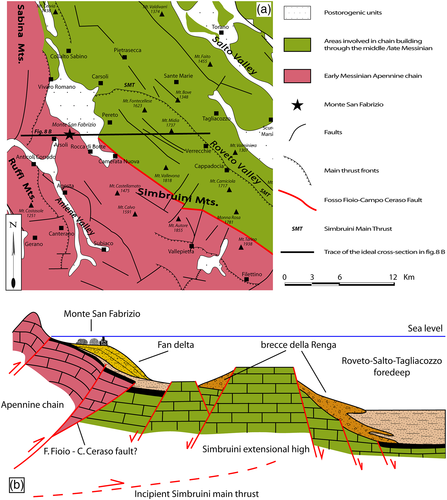
In summary, while the limited extent and general outcrop conditions prevent any further investigation regarding the three-dimensional geometry and evolution of the MSFU, our new data, compared with the case histories described in the literature (e.g., Bassi, Carannante, Murru, Simone, & Toscano, 2006; Bernasconi et al., 2015; Bossio et al., 1996; Esteban et al., 1978; Hayward et al., 1996; Karabıyıkoğlu et al., 2005; Romano et al., 2007; Saint Martin, 1996), all consistently indicate that the MSFU developed in a shallow-water nearshore/deltaic setting.
4 AGE
The substrate of the MSFU is the regional upper Miocene terrigenous succession, whose age has been determined for the present work through microfossil and nannofossil analysis, with results consistent with the regionally known ages of the UAM (lower Tortonian), and the siliciclastic foredeep units (uppermost Tortonian/lower Messinian—see Compagnoni et al., 2005; Fabbi & Rossi, 2014; Fabbi et al., 2014; Fabbi, 2016; Pampaloni et al., 1994).
A number of samples have been analysed for micro- and macro-palaeontological content, in order to derive age information on the MSFU. Despite all our efforts, we were unable to obtain useful results, due to the barren nature of the rare pelitic horizons (and of the pelites entrapped among algal laminae). A tentative hypothesis for the MSFU age can be nevertheless formulated by taking into account the geological/palaeogeographical setting along with the palaeontological evidence.
The siliciclastic turbidites at Monte San Fabrizio were sedimented in a borderline setting between the Latina Valley trough (developed in the late Tortonian) and the the Val Roveto–Salto–Tagliacozzo basin (U. Chiocchini & Cipriani, 1989; U. Chiocchini, Cipriani, Di Giacomo, Giacchetta, & Macri, 1988; Critelli et al., 2007; Fabbi, 2016; Milli & Moscatelli, 2000; Moscatelli et al., 2004), whose age is essentially early Messinian (Compagnoni et al., 2005; Fabbi, 2016) and which, according to Castorina et al. (1996), would remain the site of foredeep sedimentation until the Messinian Salinity Crisis (Krijgsman, Hilgen, Raffi, Sierro, & Wilson, 1999, and references therein). Due to the above considerations, a younger age for the MSFU would be expected. The occurrence of Siderastrea crenulata, however, firmly constrains the MSFU to the pre-Messinian Salinity Crisis. The latter event represented in fact the last stand for the Mediterranean z-corals, causing their almost total extinction in the Mediterranean, with the sole exception of the genus Porites, which was able to survive the salinity crisis and to form small monogeneric reefs up to the latest Messinian in the western Mediterranean (Perrin & Bosellini, 2013; Vertino et al., 2014). The common species Cladocora caespitosa, which is the only z-coral currently living in the Mediterranean, colonized the area only in the early Pliocene (Montagna, McCulloch, Mazzoli, Silenzi, & Odorico, 2007; Vertino et al., 2014). Although also Siderastrea crenulata was mentioned in the upper Pliocene of the Northern Apennines (Montanaro, 1931), this occurrence is considered dubious by more recent studies (Vertino et al., 2014). Given the above considerations, the MSFU must record sedimentation in an early–middle (pre-evaporitic) Messinian environment.
5 PALAEOGEOGRAPHIC REMARKS
The palaeogeographic setting of the study area in the early Messinian is still the object of debate (Bigi et al., 2003; Critelli et al., 2007; Fabbi et al., 2014; Milli & Moscatelli, 2000).
In particular, certain authors consider the whole Simbruini ridge as having been involved in the chain since the early Messinian (Billi et al., 2006; Cipollari & Cosentino, 1995; Cipollari, Cosentino, & Parotto, 1995; Cipollari, Cosentino, & Gliozzi, 1999; Cosentino & Cipollari, 2012), while other authors believe that at least the eastern part of the Simbruini ridge had to be still in a pre-thrusting extensional condition up to the latest early Messinian (Carminati et al., 2014; Fabbi, 2016; Fabbi et al., 2014).
As it was mentioned above, the sedimentological and compositional features of the MSFU indicate it was deposited in a shallow-water environment. This environment has most likely to be referred to a wedge-top setting, as the MSFU rests above the uplifted substrate through an angular unconformity.
In the Simbruini–Ernici region, several outcrops attest the existence of at least two sedimentary cycles in wedge-top basins, unconformably overlying the regional substrate.
The first cycle is essentially lower-middle Messinian (also recording the Salinity Crisis) and is characterized by massive sands, clays, and conglomerates exposed in the Latina valley, above the deformed foredeep unit (Torrice, Fumone, Collepardo), as well as in the innermost portion of the Simbruini Mts. (Trevi nel Lazio). During the development of these basins, the easternmost Simbruini Mts. were still an extensional structural high, as testified by the sedimentology and deformation patterns of the brecce della Renga fm. (Carminati et al., 2014; Fabbi, 2016; Fabbi et al., 2014). The second cycle is interpreted as being uppermost Messinian—lower Pliocene (Cavinato et al., 2012; Cipollari & Cosentino, 1999; Cosentino & Cipollari, 2012), and is represented by scattered outcrops of clays and coarse polygenic conglomerates along the culmination of the mountain ridge (Fonte Moscosa, Colle Cenciarella), which also include exotic pebbles belonging to “internal” geological domains that had already experienced orogenic uplift.
The MSFU, as amply discussed above, has to be assigned to the first sedimentary cycle, and as such, it can be linked with the outcrops occurring in the innermost Simbruini ridge, rather than to those occurring along the culmination of the ridge.
The exposed data allow to outline the following picture (Figure 8): While in the inner portions of the Simbruini–Ernici ridge, the migration of the chain front produced a number of isolated wedge-top basins in the early Messinian, the Roveto Valley was still a portion of a foredeep affected by extensional tectonics (Critelli et al., 2007; Fabbi & Rossi, 2014; Milli & Moscatelli, 2000). The coexistence of both compressional and extensional features in adjacent areas in the early Messinian, already inferred by Milli and Moscatelli (2000), Moscatelli et al. (2004), Bigi et al. (2003), and Fabbi et al. (2014), can be explained by taking into account that the main chain-building phase in the Central Apennines took place through the Messinian–early Pliocene interval (Cavinato et al., 2012; Cosentino et al., 2010; Cosentino & Cipollari, 2012), and the rapid eastward migration of the chain could have produced stepwise shifts from extensional to compressional structural regimes over a short time and across a small area. In this framework, the neighbouring Fosso Fioio—Campo Ceraso Fault (Fabbi, 2013), previously interpreted as a fault with complex kinematic behaviour separating two tectonic subunits (Compagnoni et al., 2005), can be reinterpreted as a major structural element, which separates two tectonic units characterized by a different structural and palaeoenvironmental evolution in the early Messinian.
6 CONCLUSIONS
The Monte San Fabrizio Unit (MSFU) represents a geological unicum in the Central Apennines, unconformably resting above the uplifted regional terrigenous succession. It records sedimentation in a shallow-water wedge-top setting during the building phase of the Central Apennine chain. Only the uplift, subaerial exposure, and erosion of large portions of the stratigraphy of the neighbouring deep-water Sabina Domain, and subsequent sediment transport by rivers, can account for the strikingly heterogeneous composition of the conglomerates found in the MSFU. In addition, their sedimentological characters (i.e., shape and size of the clasts) coupled with borings of the pebbles by lithophagous organisms suggest reworking in a coastal environment. A shallow water, photic environment is confirmed by the presence of zooxanthellate corals (Siderastrea crenulata and Porites sp.), red algae, and abundant macrofauna. The occurrence of Siderastrea crenulata constrains the age of the MSFU as early–middle Messinian, predating the salinity crisis. This suggests that at least the inner portion of the Simbruini Mts. was already a part of the accretionary prism in the early Messinian, while the easternmost portion of the ridge was still affected by extensional tectonics.
ACKNOWLEDGEMENTS
The authors are grateful to Antonio Russo and Ruggero Matteucci for fruitful discussions and advise on coral taxonomy. Rita M. Pichezzi and Mariagrazia Rossi are warmly thanked for having performed several microfossil and nannofossil analyses on the MSFU. Maurizio D'Orefice and Marco Pantaloni helped in the field. Domenico Mannetta is thanked for producing high-quality thin sections.



